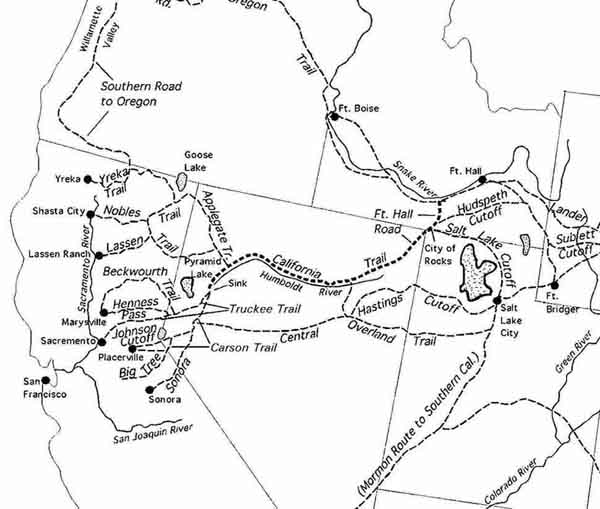
#799 - The Overland Emigrant Trail
Posted by:  Touchstone
Touchstone
N 39° 03.713 W 121° 05.313
10S E 665377 N 4325382
A nice wide turnout on Hwy 49 between Auburn and Grass Valley is the home of this marker commemorating the old emigrant trail that used to run by here.
Waymark Code: WMWF7
Location: California, United States
Date Posted: 10/26/2006
Views: 69
The official plaque reads:
Over a hundred years ago, this trail resounded to creaking wheels of pioneer wagons and the cries of hardy travelers on their way to the gold fields. It is estimated that over thirty thousand people used this trail in 1849. Here the old trail approaches the present highway.
Although I believe the following quote would probably be more appropriate:
O do not leave my bones here. If possible let them lay at home, if
not here, let it be California. The idea of the plains is horrible!
I now see my journey in its true light & if I am permitted to record, the
pages of my journal will tell a fearful tale.

Nowadays, as we zoom by in our air conditioned car, over 150 years after one
of the great emigrations of all time, it's hard to imagine the hardships that
the settlers and gold seekers went through to reach this spot. Over 2,000
miles from the Missouri River, over plains and mountains, through streams and
rivers, encountering wild animals and savages (although there is more myth than
fact to that assertion), some 300,000 people struggled to the promised
land. Many died along the route, buried in unmarked and lonely graves, but
for those that successfully made the trek, California must have truly seemed the
land of milk and honey.
By the Civil War, most emigrant trails had been either converted into or
replaced by toll roads, freighting roads, or stage lines. New mining
communities that had sprung up in the surrounding territories to the east and
northeast of California accelerated this road building activity. The
construction of the first transcontinental railway-by linking together the Union
Pacific and Central Pacific Railroads in 1869-completed the transformation of
emigrant trails. Now emigrants could travel west or east not only on a
well developed network of wagon roads but on railroads (or even on roads
alongside railway tracks). Emigrants in their wagons, however, would
continue crisscrossing the west for much of the remaining century. By this
time railroads and road building had relegated the original emigrant trails to
the pages of history.
Reference: Trails
West: Markers of the California Trail